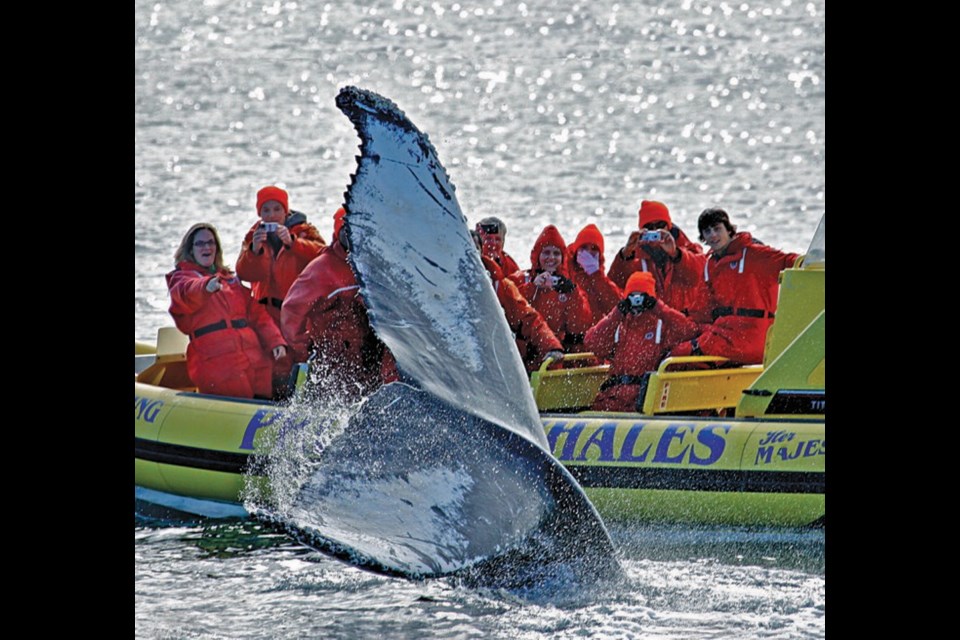From a five-minute boat ride out of downtown Victoria to halfway to Port Angeles, record numbers of humpback whales are foraging, leaping and singing to the awe of naturalists and tourists alike.
“We’ve never seen anything like this,” said Michael Harris, executive director of the Pacific Whale Watch Association. The organization represents 38 whale-watching companies in B.C. and Washington, and works with whale researchers.
“We’re seeing all sorts of behaviours: breaching, peck slapping, vocalizations above water.”
Not long ago, it was rare to spot a humpback in the Salish Sea, Harris said. Now groups of 15 and 20 are found foraging and lunge-feeding almost daily.
“There are groups working together to lunge-feed. They explode to the surface with these huge mouths open,” said Harris about the enormous whales known as gulp-feeders. “This is good because they’re feeding and thriving, but we’re not sure what they’re eating.”
Humpbacks have made a slow comeback to Vancouver Island waters since they were hunted to the brink of extinction by the commercial whaling industry in the early 1900s. Thousands of nearly 40-tonne carcasses of humpbacks were towed to whaling stations on Cortes and Hornby islands, where blubber was rendered into oil and sold to make fertilizer and cosmetics.
Harris said when the whaling industry was closed in the mid-1960s, only about 1,600 humpbacks were left in the Pacific Northwest.
“Then 20 years ago, we saw Big Mama,” said Harris, referring to a female humpback who was first spotted in 1997 and later returned to the Salish Sea with several calves over the years.
Other whales must have somehow figured out this was a safe place to be, Harris said. The population has steadily recovered. He estimates there are about 21,000 whales in this region.
“It’s hugely exciting, but these animals are new to the area and new to us. With that comes responsibility,” Harris said. “We’re very careful out there.”
The resurgence of the whales is a prime opportunity to study and observe them, to find out why they are here and how that might impact the local ecology, Harris said.
We need to understand more about the conditions that brought them here and what they are eating, he said.
“That’s why we need science,” said Harris, whose organization works closely with the Cascadia Research Collective.
A University of Victoria doctoral student is doing just that. Rhonda Reidy has been a naturalist and marine educator for 20 years. She also captains a boat for Prince of Whales whale-watching tours, which operates out of the Inner Harbour.
“[Humpbacks] are increasing in numbers in B.C. waters. These are large-bodied consumers with high metabolic demands. It’s critical to find out what they’re eating,” said Reidy, who plans to make this her primary area of research.
The sharp increase in humpbacks might indicate a shift in oceanographic and ecological conditions that affect the local food chain, she said.
Humpbacks are known foragers who seek out an abundance of prey such as large schools of small fish and krill, Reidy said. What exactly is drawing them here is not known.
“It’s a bit of a mystery,” Reidy said. “But they may be eating valuable resources for local salmon and herring.”
This is why it’s crucial to identify the humpbacks’ preferred prey in this region and how much they’re eating.
“Without knowing their food requirements, I am concerned we won’t be able to manage the humpback whale recovery and commercial fisheries,” she said.
Humpbacks in B.C.
• Humpback whales are migratory, weigh up 40 tonnes and grow up to 18 metres. A newborn weighs about a ton. They can live up to 50 years.
• In the 1800s, the first commercial whalers hunted humpbacks off the coast of Vancouver Island.
• Humpback blubber was rendered into oil at processing plants along the island. Places such as Whaling Station Bay on Hornby Island are reminders of this.
• Commercial whaling from permanent shore-based stations took place in B.C. from 1905 to 1967. In that time, more than 25,000 whales were killed.
• In 1965, humpback whales became protected in Canada. At this time, humpbacks had been hunted to near-extinction with a population of 1,600.
• Humpback whales started to return to the Salish Sea in the mid-1990s.
• Humpbacks are listed as a Species at Risk in Canada.
• The humpback population is increasing by about six per cent a year.
• Humpbacks are known for their long pectoral fins, aerial breaches and slapping, and as being singers. Mostly male humpbacks produce a low audible “song” during what is thought to be the mating period.



